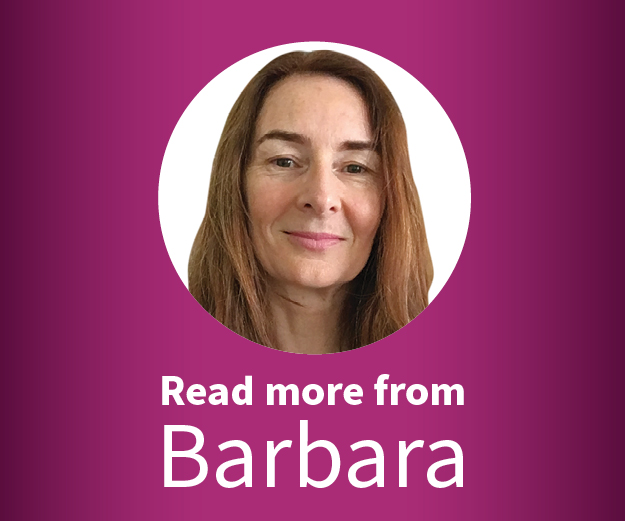Respiratory physician Lutz Beckert considers chronic obstructive pulmonary disease management, including the prevention of COPD, the importance of smoking cessation and pulmonary rehabilitation, and the lifesaving potential of addressing treatable traits. He also discusses the logic of inhaler therapy, moving from single therapy to dual and triple therapy when indicated, as well as other aspects of management
More than two, but not many
More than two, but not many

Editor Barbara Fountain finds herself getting picky over notions of how general practice is portrayed
COVID put a slight spanner in the works, but stuff was happening, and it was more than “some” and more than “several”
Say “several” and what pops into your mind? Four, five, a dozen? The dictionary definition is, “More than two but not many.” That sounds about right. This is why when journalist Martin Johnston was reading through the Te Whatu Ora March 2023 presentation Primary care overview – reimagining general practice, he stopped short at the paragraph:
“Several general practices across the country currently utilise new roles within their practices as part of initiatives, such as Healthcare Homes, Te Tumu Waiora – primary mental health and addiction care, and other local innovations.”
In this case, “several” runs a little higher than the accepted definition, given that more than 200 practices were participating in the Health Care Home initiative at the time. By October 2023, over 500 were implementing Te Tumu Waiora, and that didn’t happen overnight.
Those figures add up to more than “several”.
Martin Hefford of Te Whatu Ora dismisses the 2023 report, released to New Zealand Doctor Rata Aotearoa under the Official Information Act, as merely a snapshot in time. We have moved on from then, Mr Hefford says.
But imagine this, if you will: It is March 2023, and the board of Te Whatu Ora has been in place for nine months. For some board members sitting on the Public Health, Community, and Primary Care Committee meeting, this might be the first time their focus has truly turned to general practice.
The presentation is prepared by the group manager, primary health care system improvement and innovation, commissioning.
It is titled Primary care overview – reimagining general practice and comes with an appendix, “Overview – Primary care (General Practice) Deep Dive”.
There are plenty of home truths that no one would argue with – the importance of a highly functioning primary care sector, the failure of the funding formula, the fragmentation of the sector, the ageing workforce and assistant shortages.
However, the constant referral to “traditional” general practice could leave the uninitiated jumping to the conclusion that most practices still operate out of converted houses in the suburbs, with a GP or two hanging out a shingle and a spouse employed as a practice nurse.
Was someone watching too many Doc Martin reruns?
The paper’s appendix does concede there has been change in general practice, stating: “In some practices serving high-needs communities, general practices have extended clinical and support staff working in a variety of roles, for example, social workers, kaiāwhina or community health workers, health improvement practitioners and health coaches.” And “increasingly, even mainstream practices are employing Health Care Assistants roles as non-regulated clinical assistants”.
Let’s just stop there for a minute.
“Some” is, by definition, “at least a small amount or number of people or things”.
Those 500 or so practices involved in Te Tumu Waiora (later renamed Integrated Primary Mental Health and Addiction) utilised those new roles. COVID put a slight spanner in the works, but stuff was happening, and it was more than “some” and more than “several”.
When I read this I feel aggrieved on behalf of general practice that the hard work being undertaken by practices is being downplayed, not necessarily with any malevolent intent but through inadequate attention to detail and a reliance on old knowledge.
When the paper talks of traditional general practice being under pressure from “for-profit” providers, I’m left wondering, “Do they not realise that general practice is a for-profit endeavour or, at the minimum, a not-for-loss?”
Corporates are credited with greater economies of scale and the cash flow to invest in new technology but are deemed to lack the flexibility to tailor to local needs and provide culturally responsive care. It is also suggested that their presence increases inequities and pushes out smaller community-focused general practices.
I’m being picky, of course. But this paper was presented to a relatively new board committee and came two and a half years after the establishment of the Transition Unit tasked with rolling out the reforms – plenty of time to gather some nuance on the primary care sector.
And so, I come to our cover story (see pages 6 and 7). Yet, again, poor planning and implementation by the Ministry of Health and Te Whatu Ora have pitted general practice and pharmacy against each other, as both sectors battle to deliver health services with insufficient funding. This time, the battle involves the most vulnerable – infants and new mothers.
The Te Whatu Ora papers received by Fiona Cassie reveal how easy it was for decision-makers not to consult early with the sector over changes to childhood vaccination services or to address the funding issues.
With health minister Shane Reti indicating significant changes to capitation and primary care funding are still at least 12 to 15 months away, the primary care sector players will continue to struggle against each other, unfairly adding fuel to the simplistic notion of general practice as intransigent and unwilling to “reimagine” itself.
We're publishing this article as a FREE READ so it is FREE to read and EASY to share more widely. Please support us and our journalism – subscribe here
One of the benefits of subscribing is you will also be able to share your thoughts about what you read with others in our Comment Stream. You can also take notes on what you read with Capture
TELL US WHAT YOU THINK
You can add your comments using the comment function below, or by sending a Letter to the Editor to editor@nzdoctor.co.nz



![Man climbing paper stack [Image: Luis Portugal on iStock]](/sites/default/files/styles/cropped_image_4_3/public/2024-03/Man_climbing_paper_Stack_CR_LuisPortugal_on_iStock-638286148.jpg?itok=o1pEJoUg)






![Barbara Fountain, editor of New Zealand Doctor Rata Aotearoa, and Paul Hutchison, GP and senior medical clinician at Tāmaki Health [Image: Simon Maude]](/sites/default/files/styles/thumbnail_cropped_100/public/2025-03/Barbara%20Fountain%2C%20editor%20of%20New%20Zealand%20Doctor%20Rata%20Aotearoa%2C%20and%20Paul%20Hutchison%2C%20GP%20and%20senior%20medical%20clinician%20at%20T%C4%81maki%20Health%20CR%20Simon%20Maude.jpg?itok=-HbQ1EYA)
![Lori Peters, NP and advanced health improvement practitioner at Mahitahi Hauora, and Jasper Nacilla, NP at The Terrace Medical Centre in Wellington [Image: Simon Maude]](/sites/default/files/styles/thumbnail_cropped_100/public/2025-03/2.%20Lori%20Peters%2C%20NP%20and%20advanced%20HIP%20at%20Mahitahi%20Hauora%2C%20and%20Jasper%20Nacilla%2C%20NP%20at%20The%20Terrace%20Medical%20Centre%20in%20Wellington%20CR%20Simon%20Maude.jpg?itok=sUfbsSF1)
![Ministry of Social Development health and disability coordinator Liz Williams, regional health advisors Mary Mojel and Larah Takarangi, and health and disability coordinators Rebecca Staunton and Myint Than Htut [Image: Simon Maude]](/sites/default/files/styles/thumbnail_cropped_100/public/2025-03/3.%20Ministry%20of%20Social%20Development%27s%20Liz%20Williams%2C%20Mary%20Mojel%2C%20Larah%20Takarangi%2C%20Rebecca%20Staunton%20and%20Myint%20Than%20Htut%20CR%20Simon%20Maude.jpg?itok=9ceOujzC)
![Locum GP Helen Fisher, with Te Kuiti Medical Centre NP Bridget Woodney [Image: Simon Maude]](/sites/default/files/styles/thumbnail_cropped_100/public/2025-03/4.%20Locum%20GP%20Helen%20Fisher%2C%20with%20Te%20Kuiti%20Medical%20Centre%20NP%20Bridget%20Woodney%20CR%20Simon%20Maude.jpg?itok=TJeODetm)
![Ruby Faulkner, GPEP2, with David Small, GPEP3 from The Doctors Greenmeadows in Napier [Image: Simon Maude]](/sites/default/files/styles/thumbnail_cropped_100/public/2025-03/5.%20Ruby%20Faulkner%2C%20GPEP2%2C%20with%20David%20Small%2C%20GPEP3%20from%20The%20Doctors%20Greenmeadows%20in%20Napier%20CR%20Simon%20Maude.jpg?itok=B0u4wsIs)
![Rochelle Langton and Libby Thomas, marketing advisors at the Medical Protection Society [Image: Simon Maude]](/sites/default/files/styles/thumbnail_cropped_100/public/2025-03/6.%20Rochelle%20Langton%20and%20Libby%20Thomas%2C%20marketing%20advisors%20at%20the%20Medical%20Protection%20Society%20CR%20Simon%20Maude.jpg?itok=r52_Cf74)
![Specialist GP Lucy Gibberd, medical advisor at MPS, and Zara Bolam, urgent-care specialist at The Nest Health Centre in Inglewood [Image: Simon Maude]](/sites/default/files/styles/thumbnail_cropped_100/public/2025-03/7.%20Specialist%20GP%20Lucy%20Gibberd%2C%20medical%20advisor%20at%20MPS%2C%20and%20Zara%20Bolam%2C%20urgent-care%20specialist%20at%20The%20Nest%20Health%20Centre%20in%20Inglewood%20CR%20Simon%20Maude.jpg?itok=z8eVoBU3)
![Olivia Blackmore and Trudee Sharp, NPs at Gore Health Centre, and Gaylene Hastie, NP at Queenstown Medical Centre [Image: Simon Maude]](/sites/default/files/styles/thumbnail_cropped_100/public/2025-03/8.%20Olivia%20Blackmore%20and%20Trudee%20Sharp%2C%20NPs%20at%20Gore%20Health%20Centre%2C%20and%20Gaylene%20Hastie%2C%20NP%20at%20Queenstown%20Medical%20Centre%20CR%20Simon%20Maude.jpg?itok=Z6u9d0XH)
![Mary Toloa, specialist GP at Porirua and Union Community Health Service in Wellington, Mara Coler, clinical pharmacist at Tū Ora Compass Health, and Bhavna Mistry, specialist GP at Porirua and Union Community Health Service [Image: Simon Maude]](/sites/default/files/styles/thumbnail_cropped_100/public/2025-03/9.%20Mary%20Toloa%2C%20Porirua%20and%20Union%20Community%20Health%20Service%20in%20Wellington%2C%20Mara%20Coler%2C%20T%C5%AB%20Ora%20Compass%20Health%2C%20and%20Bhavna%20Mistry%2C%20PUCHS%20CR%20Simon%20Maude.jpg?itok=kpChr0cc)